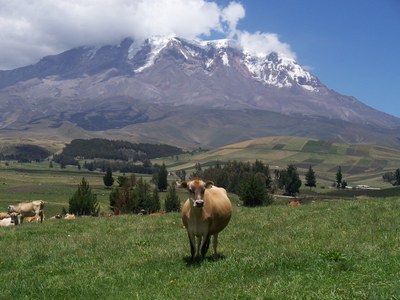Mooove to Ecuador: Cattle Ranches
 Ecuadorian Cattle: Overview
Ecuadorian Cattle: Overview
Since 1943, there has never been a better time to consider cattle ranching in Ecuador. Owning a cattle ranch is not for the faint of heart, and so this article is geared towards those who have experience with cattle ranching and want to learn more about starting a ranch in Ecuador. The market is growing quickly. For the past multiple decades, Ecuadorian cattle suffered from various diseases. The exportation and importation of live animals was prohibited for more than a decade. However, since 2011 the Ecuadorian government has sponsored an “Eradication of Foot and Mouth Disease” project, aimed at wiping out this debilitating disease that has been prevalent in Ecuadorian beef since 1943.
Prior to 2011, only half of the cattle in Ecuador were vaccinated. Now, that number is 98%. The industry is growing rapidly as well, as new jobs for technicians, veterinarians, and technological and research development emerge. Just this past June, the World Organization for Animal Health announced that Ecuador has eradicated foot and mouth disease. Since receiving this validation, Ecuador can now export beef to international markets. Agricultural spokesman Luis Valverde says the country will reestablish beef export trade with Venezuela, Iran, Cuba and Panama, as well as hopefully Peru and Russia. All of these factors mean that it is game-on for breeders and ranchers in Ecuador.
Over the next three years, the Ecuador government plans to purchase 20,000-30,000 head of cattle.
Ecuadorian Cattle Breeds
The government will sell the cattle to small and medium-sized ranchers with the hope of rebuilding the national herd of cattle and exporting regional beef by 2017. Brangus, Braford, and Brahman cattle are being imported from Paraguay and Texas to diversify the cattle breeds in Ecuador. Brahman cattle, from Texas, are known for their resilience to humid climates. They’re incredibly adaptable. Braford breeds have always been recognized for their superior maternal abilities. Brangus breeds prefer dryer climates, but they were bred to fit many needs. These three breeds are the breeds selected by the Ecuadorian government to upgrade the genetic stock of the cattle, as well as to increase the number of purebred cattle. There are other humidity-resistant breeds of cattle, like the Jersey cow, that could fare well in the Ecuadorian climate. Jersey cows are both heat and insect resistant. Depending on the region where you want to start your ranch, the cattle will have to adapt to the environmental factors.
Ecuadorian Cattle: Future of the Market
As of 2014, most cattle ranches were located in the Azuay and Manabi provinces of Ecuador. The Manabi climate is dry to humid subtropical, with the average temperature hovering around 25 degrees Celsius. Larger cities in the Manabi province, like Manta, are known for their scenic views. The Azuay province includes Cuenca, the third largest city in Ecuador. Average temperatures in the Azuay province are around 15 degrees Celsius. The highland climate in Azuay is very temperate. Properties along the coast could work as well, as long as the cows are bred for adaptability and resilience.
 When considering the market, it’s important to realize that the Ecuadorian beef market is in its infancy, but it is growing rapidly. Experts in cattle write there is reason to believe Ecuador’s market will follow similar trends as the rest of South America. The global beef market is dominated by India, Australia, Brazil and the United States. The U.S. produces 20% of the world’s beef, but it is home to only 9% of the world’s cattle and 4% of the global population. In comparison, 40% of the global population lives in India, Brazil and China, as well as 60% of the world’s cattle exports.
When considering the market, it’s important to realize that the Ecuadorian beef market is in its infancy, but it is growing rapidly. Experts in cattle write there is reason to believe Ecuador’s market will follow similar trends as the rest of South America. The global beef market is dominated by India, Australia, Brazil and the United States. The U.S. produces 20% of the world’s beef, but it is home to only 9% of the world’s cattle and 4% of the global population. In comparison, 40% of the global population lives in India, Brazil and China, as well as 60% of the world’s cattle exports.
Cattle production is falling in the United States, but it is rising in South America. From 1999 and 2009, the United States’ production of beef declined by 5% while in Brazil, Uruguay and Paraguay, production increased by 33%, 22 %, and 39%, respectively. The largest obstacles for South American cattle ranchers are production efficiency and utilizing new technology and methods. However, these factors aside, reports from magazines like Progressive Cattle predict the South American beef market will only continue to grow in the next few years. Very soon, Ecuador will join Paraguay, Uruguay, Argentina, Chile and Brazil in cattle exportation.
Getting Started with a Cattle Ranch in Ecuador
If owning a cattle ranch is intriguing, talking to a real estate agent is necessary in order to secure a larger property, especially one with water rights and fertile land. As the Ecuadorian government invests more in the cattle industry, there are more opportunities for farms to get started. John Vollmecke, of Ecuador Homes and Lands, works with all types of properties, from agricultural farms to ranches to beachfront property. Contact him if you want to learn more about the properties and their agricultural potential.
Resources
http://www.bovinebazaar.com/whythisbreed.htm
http://www.countrysidemag.com/91-3-heather-smith-thomas-2/
http://www.stricklandranch.com/news/cattle-shipment-to-ecuador-reopens-important-market/
http://www.cuencahighlife.com/wheres-the-beef-its-on-its-way-from-texas-and-paraguay/

